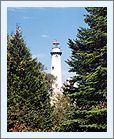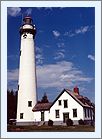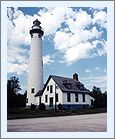|
Historical Information

At the dawn of the nineteenth century, the spit of land protruding from
the eastern shore of Lake Huron had already been known as Presque Isle
for over a hundred years, after French trappers seeking welcome shelter
in the natural harbor on the peninsula's southern lee side gave it the
name "almost an island." By 1830 the area took on additional
significance, as steam-powered vessels began stopping here to stock up
on wood to feed their hungry boilers. So important was this natural
harbor of refuge that many an up-bound captain decided to turn tail back
to Fort Gratiot finding himself unable to make the safety of Presque
Isle during a gut-busting Nor'wester.
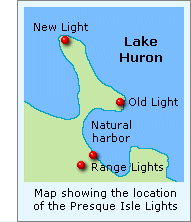 The
first Presque Isle Light had been established in 1840 to serve as a
guide to mariners seeking the harbor. However, by 1866 the District
Inspector reported that the dwelling was in such deteriorated condition
that nothing short of a complete rebuild would suffice to render the
structure safe and fit for habitation. Congress appropriated $7,000 for
the work on March 2, 1867, and some of the materials had already been
delivered at the station when the Lighthouse Board revised its plans for
lighting the area. Observing that the 1840 tower's location and
diminutive height served only as a guide to vessels already close by the
harbor, the Board suggested that a new first class coastal light station
be constructed two miles to the north near the tip of the peninsula,
where it would be able to serve both functions, allowing the
discontinuation of the old 1840 Light. The
first Presque Isle Light had been established in 1840 to serve as a
guide to mariners seeking the harbor. However, by 1866 the District
Inspector reported that the dwelling was in such deteriorated condition
that nothing short of a complete rebuild would suffice to render the
structure safe and fit for habitation. Congress appropriated $7,000 for
the work on March 2, 1867, and some of the materials had already been
delivered at the station when the Lighthouse Board revised its plans for
lighting the area. Observing that the 1840 tower's location and
diminutive height served only as a guide to vessels already close by the
harbor, the Board suggested that a new first class coastal light station
be constructed two miles to the north near the tip of the peninsula,
where it would be able to serve both functions, allowing the
discontinuation of the old 1840 Light.
District Engineer Orlando M Poe drew up
plans and specifications for the station and estimating a total
construction cost of $28,000, the Board requested an appropriation for
the amount in its 1869 annual report. Congress responded with a number
of partial appropriations for the work over early 1870, with the final
appropriation made on July 15. With the necessary funding available, Poe
wasted no time, immediately obtaining bids for labor, construction
materials and the required mechanical components. Later that summer, the
lighthouse tender WARRINGTON arrived at Presque Isle and unloaded both a
working party and materials, and work at the site began at a feverish
pace.
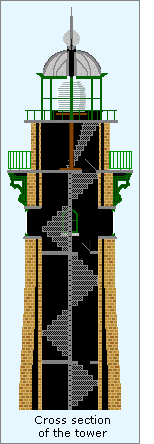 Poe's classic design for the new tower
was atypically elegant for such a utilitarian structure, and was so
successful that it would be duplicated at a number of stations
throughout the district, including Outer Island and
Au Sable Point on
Lake Superior, and at Little
Sable, Big Sable and
Grosse Point on Lake
Michigan. Erected on a limestone foundation that extended almost ten
feet below grade, the red brick tower stood 113 feet in height. 19 feet
3 inches in exterior diameter at the base, the structure tapered
gracefully to a diameter of 12 feet beneath the gallery. Constructed
with a double wall system, the outer walls stood 5 feet three inches in
thickness at the base and the inner wall one 1 foot thick with a 2 foot
three inch air space between. The inner walls did not reflect the taper
of the exterior, but were erected as a pure cylinder, encasing a spiral
cast iron stairway consisting of 138 steps and incorporating five
landings and a watch room with four windows immediately below the
gallery. Each of these windows featured a graceful arched top section,
typical of Poe's groundbreaking design. Poe's classic design for the new tower
was atypically elegant for such a utilitarian structure, and was so
successful that it would be duplicated at a number of stations
throughout the district, including Outer Island and
Au Sable Point on
Lake Superior, and at Little
Sable, Big Sable and
Grosse Point on Lake
Michigan. Erected on a limestone foundation that extended almost ten
feet below grade, the red brick tower stood 113 feet in height. 19 feet
3 inches in exterior diameter at the base, the structure tapered
gracefully to a diameter of 12 feet beneath the gallery. Constructed
with a double wall system, the outer walls stood 5 feet three inches in
thickness at the base and the inner wall one 1 foot thick with a 2 foot
three inch air space between. The inner walls did not reflect the taper
of the exterior, but were erected as a pure cylinder, encasing a spiral
cast iron stairway consisting of 138 steps and incorporating five
landings and a watch room with four windows immediately below the
gallery. Each of these windows featured a graceful arched top section,
typical of Poe's groundbreaking design.
 Supported by a series of ornate cast
iron corbels, the gallery provided a convenient location from which the
keepers could observe vessels out on the lake during fair weather, and
created a natural location from which to suspend a boatswain's chair to
conduct maintenance on the gallery supports and the masonry of the tower
walls. Centered on the gallery, a prefabricated cast iron apparatus room
was erected with a smaller encircling gallery. Centered within this
secondary gallery, a cast iron lantern with vertical astragals was
equipped with hand-holds to provide the keepers with an extra measure of
safety while standing on the narrow upper gallery when cleaning or
scraping ice from the plate glass lantern panes. A large cast iron
pedestal to support for the lens was erected in the mechanical room
below the lantern, and the massive Third Order Fresnel
lens, which had
been ordered from Henry LePaute Cie. of Paris assembled at its upper
flare. Consisting of a brass support structure standing 8 feet in
diameter, ten prismatic panels, each six feet in height and 2 feet 6
inches wide were carefully assembled within the frame to create the
"crystal beehive" look typical of such lenses. Since the lens
was to exhibit a fixed white light, it did not need to rotate, and thus
was not equipped with any clockwork rotating mechanism. However, as was
almost always the case with towers that were originally designed with
fixed lights, a weight pocket and access doors were built into the tower
walls to facilitate the installation of such equipment should a change
in characteristic be desired at some later point in time. Supported by a series of ornate cast
iron corbels, the gallery provided a convenient location from which the
keepers could observe vessels out on the lake during fair weather, and
created a natural location from which to suspend a boatswain's chair to
conduct maintenance on the gallery supports and the masonry of the tower
walls. Centered on the gallery, a prefabricated cast iron apparatus room
was erected with a smaller encircling gallery. Centered within this
secondary gallery, a cast iron lantern with vertical astragals was
equipped with hand-holds to provide the keepers with an extra measure of
safety while standing on the narrow upper gallery when cleaning or
scraping ice from the plate glass lantern panes. A large cast iron
pedestal to support for the lens was erected in the mechanical room
below the lantern, and the massive Third Order Fresnel
lens, which had
been ordered from Henry LePaute Cie. of Paris assembled at its upper
flare. Consisting of a brass support structure standing 8 feet in
diameter, ten prismatic panels, each six feet in height and 2 feet 6
inches wide were carefully assembled within the frame to create the
"crystal beehive" look typical of such lenses. Since the lens
was to exhibit a fixed white light, it did not need to rotate, and thus
was not equipped with any clockwork rotating mechanism. However, as was
almost always the case with towers that were originally designed with
fixed lights, a weight pocket and access doors were built into the tower
walls to facilitate the installation of such equipment should a change
in characteristic be desired at some later point in time.
 A covered passageway 16 feet in length
connected the tower to the two-story, 31 foot square red brick keepers
dwelling. The covered passageway was designed to provide a measure of
protection for the keepers when moving from dwelling to tower during
inclement weather conditions. The dwelling was erected on a full cellar,
which as well as being used for domestic storage, contained a room for
the storage of oil for the lamp. A covered passageway 16 feet in length
connected the tower to the two-story, 31 foot square red brick keepers
dwelling. The covered passageway was designed to provide a measure of
protection for the keepers when moving from dwelling to tower during
inclement weather conditions. The dwelling was erected on a full cellar,
which as well as being used for domestic storage, contained a room for
the storage of oil for the lamp.
Work on the station continued
throughout 1870 and well into the winter. However, with work reaching
completion so late in the year, the new light was not exhibited until
the opening of the 1871 navigation season. With the illumination of the
new light rendering the old 1840 station at which he had served for the
past ten years obsolete, Patrick Garrity was transferred as Keeper of
the New Presque Isle Light, and loading his family and their personal
belongings onto a wagon for the two-mile trip to the new light. While
the diminutive old Light had been considered a one-man station, the
decision was made to staff the larger New Light with both a Keeper and
Assistant, and Garrity arranged for his wife Mary to be appointed to the
position of the station's first Assistant. For some unknown reason, the
position of Assistant Keeper at the station was abolished on October 1,
1882, and the Garrity's had to live on a considerably diminished salary.
Surprisingly, the Assistant's position was reinstated four years later,
and Patrick arranged for his 18-year old son Thomas to be appointed to
the position on May 19, 1886.
 The Garrity family settled into the
daily routine, and while they were almost 30 miles from the nearest
"civilization" their life at the station was likely a
comfortable one, as their relative proximity to the Detroit depot
allowed for frequent re-supply by the lighthouse tenders on their up and
down-bound trips to the more remote stations. However, with
Congressional authorization of a $5,500 appropriation for the
construction of a first-class steam fog signal at the station on March
2, 1889, an end of their bucolic lifestyle at the end of the peninsula
was forever sealed. The Garrity family settled into the
daily routine, and while they were almost 30 miles from the nearest
"civilization" their life at the station was likely a
comfortable one, as their relative proximity to the Detroit depot
allowed for frequent re-supply by the lighthouse tenders on their up and
down-bound trips to the more remote stations. However, with
Congressional authorization of a $5,500 appropriation for the
construction of a first-class steam fog signal at the station on March
2, 1889, an end of their bucolic lifestyle at the end of the peninsula
was forever sealed.
On June 13, 1890, the steam barge RUBY
arrived at the station and unloaded a working party and materials for
construction of the new fog signal building. Also included in the
shipment were the materials for the construction of a 2,240-foot long
tramway from the boat landing to the station for the transportation of
the tons of coal that would be required to feed the hungry fog signal
boilers. While at the site, the crew also rebuilt the landing dock and
boathouse, and erected a 360-gallon capacity brick oil storage building.
Work as completed, and the new fog signal placed into operation on an as
yet unidentified date that summer. Standard Lighthouse Board practice
called for the manning of stations with fog signals with a compliment of
three keepers, consisting of a Head Keeper and First and Second
Assistants. However, this was not to be the case at Presque Isle, and
thus Patrick and Thomas were kept busy keeping both light and fog signal
in operation.
With receding lake levels through the
1890's, The Eleventh District office was kept busy modifying water
intake and boat launching facilities throughout the district. To this
end, the lighthouse tender AMARANTH delivered a work crew and materials
at Presque Isle in 1897. The landing dock was extended, and the water
supply intake for the fog signal building was relocated to a new crib at
its outer end. The tramway was extended 120 feet out along the new dock
and storm-houses were also constructed around both the front and kitchen
entrances to the dwelling.
 Eleventh District Inspector Commander
Edward H. Gheen finally acknowledged the fact that the workload at
Presque Isle was excessive for the stations two-man crew, and District
Engineer Captain Lansing H. Beach was asked to draw-up plans for a
second dwelling to accommodate an additional keeper. While under normal
circumstances such a dwelling could have been built under contract for a
few thousand dollars, the station's isolated location necessitated the
transportation of a work crew and materials from the Detroit depot,
dramatically increasing the construction costs. To this end, the
Lighthouse Board requested an appropriation of $5,000 for the
construction of a second dwelling in its 1902 annual report to Congress.
The appropriation was made on April 28, 1904, and the Detroit office
began making arrangements to begin construction the following year. A
work crew and materials were loaded on the tender AMARANTH in June 1905
and delivered to the station, and by the end of July, excavation of the
35 foot by 27 foot cellar was complete, and the concrete block walls had
been erected to the second floor joist level. Work on the new dwelling
continued through the summer, and was completed on September 15. While
at the site, the work crew also rebuilt the outer crib of the boat
landing and installed a new deck along the length of the structure. Eleventh District Inspector Commander
Edward H. Gheen finally acknowledged the fact that the workload at
Presque Isle was excessive for the stations two-man crew, and District
Engineer Captain Lansing H. Beach was asked to draw-up plans for a
second dwelling to accommodate an additional keeper. While under normal
circumstances such a dwelling could have been built under contract for a
few thousand dollars, the station's isolated location necessitated the
transportation of a work crew and materials from the Detroit depot,
dramatically increasing the construction costs. To this end, the
Lighthouse Board requested an appropriation of $5,000 for the
construction of a second dwelling in its 1902 annual report to Congress.
The appropriation was made on April 28, 1904, and the Detroit office
began making arrangements to begin construction the following year. A
work crew and materials were loaded on the tender AMARANTH in June 1905
and delivered to the station, and by the end of July, excavation of the
35 foot by 27 foot cellar was complete, and the concrete block walls had
been erected to the second floor joist level. Work on the new dwelling
continued through the summer, and was completed on September 15. While
at the site, the work crew also rebuilt the outer crib of the boat
landing and installed a new deck along the length of the structure.
1907 saw the installation of concrete
sidewalks between the station structures. The sidewalk was made of
concrete slabs which were poured in forms at the Detroit depot, and
delivered to the station on the lighthouse tender AMARANTH. All told,
105 such slabs were laid at the station.
Strangely, while the dwelling was
completed, no Second Assistant was assigned to the station for four
years, when Arthur J Cater arrived to fill the position on November 22,
1909. The illuminating apparatus at Presque Isle was upgraded to an
Incandescent Oil Vapor (IOV) system on September 25, 1912, with a
resulting increase in output to 29,000 candle power.
With responsibility for the nation's
aids to navigation transferred to the Coast Guard in 1939, the
department assumed responsibility for the operation and maintenance of
the Presque Isle Light and electricity and indoor plumbing were
installed at the station the following year. In poor structural
condition, and no longer deemed a necessity to maritime interests, both
the fog signal building and oil storage shed were demolished during the
1950's, and a large 24 foot by 65 foot concrete block garage was
constructed for the vehicles of the rotating group of seamen assigned to
the station.
The Light was automated in 1970, and
the station was boarded-u and abandoned. The structures were eventually
leased to Presque Isle Park in the 1970's to serve as a public par and
maritime museum. After the county operated the facilities for a decade,
it was plain that it had proven itself to be a good steward, and the
Coast Guard transferred the deed to the property over to the County in
1998.
The grounds are open to the public from
May through October, the 1870 keeper's dwelling ahs been restored and
operates as a combination gift shop and museum. Restoration work is
underway on the 1906 Assistant's dwelling, and the County plans to open
the structure as a museum to house its growing collection of maritime
artifacts. Visitors may climb the tower for a nominal donation, and
those who chose to do so will be rewarded with a breathtaking view of
both Lake Huron and the Presque Isle peninsula. In fact, from this lofty
viewpoint it can be clearly seen how correct the French Voyageurs were
when they named the peninsula "almost an island."
Keepers of
this Light

Click here
to see a complete listing of all Presque Isle New Light keepers compiled
by Phyllis L. Tag of Great Lakes Lighthouse Research.

Seeing this Light

The keeper’s quarters at the New Presque Isle light have been completely refurbished, and house a combined museum and gift shop.
With Sue nosing around the gift shop, I paid the two dollars to climb the 120 stairs to the top of the 108’ tower. The cast iron stairs have been carefully restored and painted, and were in the finest condition of any that I had seen. Unfortunately, I did not have a flash for my camera with me, and I was thus unable to capture them on film.
The view from the top of this tower is awesome, as one can see along the entire peninsula back to the mainland. It became dramatically plain to see why the early French named it Presque Isle, which translates as “nearly an island.“

Finding this Light

Take US23 South from Rogers City, and turn east on 638 Hwy/Highway Road.
Continue to the point at which the road splits, and take the left fork
when the road splits, staying on 638 Hwy. Continue for approximately 2
miles, and turn North on Grand Lake Road. Continue approximately one
mile until you reach the shore of the Lake. Continue past the entrance
of the Old Presque Isle Lighthouse approximately 1 1/2 miles to the New
Presque Isle Lighthouse.

Contact information

New Presque Isle Lighthouse Museum
4500 E. Grand Lake Road
Presque Isle MI 49777
(989) 595-9917

Reference Sources

 Annual reports of the Lighthouse Board, various, 1850 - 1909 Annual reports of the Lighthouse Board, various, 1850 - 1909
Annual reports of the Lighthouse Service, various, 1910 - 1939
Annual reports of the Lake Carrier's Association, various, 1909 -
1939
Inventory of Historic
Light Stations, National Parks Service, 1994
Ken Laeser's Coast Guard History Page, website
Personal observation at Presque, 09/11/1998
USCG Historian's Office -
photographic archives.
Photographs from the author's personal collection.
Keeper listings for this light appear courtesy of Tom & Phyllis Tag
|
